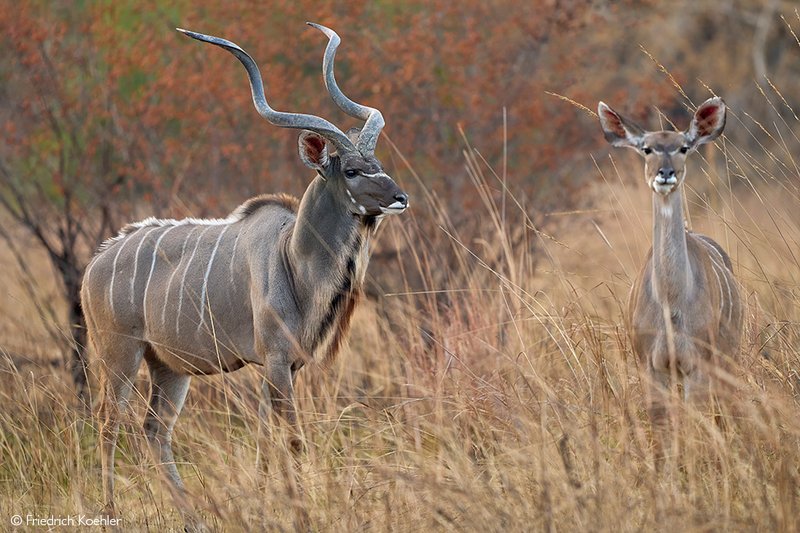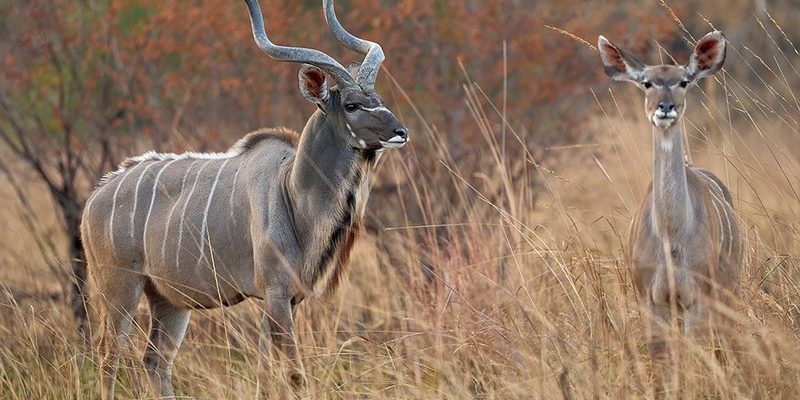
Imagine the kudu’s ancestors lumbering through ancient landscapes, facing challenges like predators and climate changes that shaped their characteristics. The story of the kudu is a reminder of nature’s resilience and ingenuity. So, grab a cup of coffee, and let’s dive into the fascinating world of kudu evolution!
Understanding the Kudu: A Quick Overview
First off, there are two main species of kudu: the greater kudu and the lesser kudu. The greater kudu, known scientifically as *Tragelaphus strepsiceros*, is larger and boasts impressive horns that can grow up to 72 inches! The lesser kudu, on the other hand, is smaller and more petite, with its scientific name being *Tragelaphus imberbis*. Now, you might be wondering what makes these antelopes unique.
Kudus are known for their striking coloration—shades of grayish-brown adorned with white stripes set them apart in their natural habitat. These stripes not only add to their beauty but also serve as a form of camouflage, helping them blend into the dappled light of their surroundings. This ability to hide from predators is crucial for their survival.
In terms of habitat, kudus prefer areas with dense bushes and trees where they can forage for leaves, fruits, and shoots. Their diet mainly consists of foliage, which is abundant in their preferred environments. Being browsers rather than grazers, they have adapted to be selective, feeding on whatever is most nutritious.
The Origins of the Kudu: Ancestral Lineage
The evolutionary history of the kudu can be traced back millions of years. Let’s take a step back in time to the Miocene epoch, around 23 million years ago, when the antelope family began to diversify. The ancestors of the kudu were part of a larger group of animals known as the Bovidae, which includes animals like cattle, sheep, and goats.
During this time, early antelopes adapted to various environments across Africa and Eurasia. As the climate changed and forests evolved into savannas, different species of antelope emerged, including the ancestors of modern kudus. With their unique adaptations, such as long legs for running and spiral horns for defense, kudus developed traits to help them thrive in these new landscapes.
Interestingly, the kudu’s evolutionary path wasn’t linear. It went through various adaptations in response to predation pressures and environmental changes. As larger predators, like lions and hyenas, roamed the plains, kudus learned to master the art of escape—hiding among the trees and utilizing their speed and agility to evade danger.
Physical Adaptations Over Time
Kudus are known for their remarkable physical adaptations that have developed over time. Their large, responsive ears are not just for show; they help detect the faintest sounds of approaching predators. This keen sense of hearing, paired with their excellent eyesight, makes them incredibly responsive to threats.
Their spiraled horns are another standout feature. Found primarily in males, these horns are not just for display; they serve as a defense mechanism during fights with other males, especially during mating season. The evolution of these horns over generations highlights a balance between sexual selection and survival. The larger and more impressive the horns, the more attractive the male is to potential mates.
Kudus also exhibit fascinating social behavior. They are generally shy and prefer to live in small groups, often consisting of females and their young. Males tend to be solitary or form bachelor herds. This group behavior is an evolutionary trait that enhances their chances of survival. By sticking together, they can alert each other to danger, increasing their overall safety.
The Role of Natural Selection in Kudu Evolution
Natural selection has played a crucial role in shaping the kudu as we know it today. The principle is fairly straightforward: those individuals better suited to their environment tend to survive and reproduce. For kudus, this means having traits that help them evade predators, find food, and adapt to changing climates.
Searching for food in dense vegetation requires a unique skill set. The kudu’s ability to browse and reach high branches gives it an advantage over other animals that may not be as nimble. Moreover, their color patterns can confuse both predators and prey. The vertical stripes create an optical illusion that breaks up their silhouette, making it hard for predators to pinpoint their location in the wild.
Another point worth noting is how climate and habitat changes have influenced kudu evolution. During warmer periods, kudus shifted their ranges to cooler, more forest-like areas, showing their resilience and adaptability. This trait is vital for survival—witnessing how these animals adjust to new environments can be a lesson in resilience for all of us.
Conservation and the Future of the Kudu
With their rich evolutionary history, kudus have faced numerous challenges in the modern world. Habitat loss due to agriculture, urbanization, and poaching presents significant threats. Conservation efforts are now more important than ever. Protected reserves have been established across Africa to ensure that these beautiful creatures can thrive.
Educational programs aimed at local communities also play a vital role in kudu conservation. When people understand the importance of preserving wildlife and ecosystems, they are more likely to participate in conservation efforts. Programs that promote sustainable farming and ecotourism can create a harmonious balance between human needs and wildlife preservation.
Honestly, the survival of kudus and their habitats can signify broader environmental health. By protecting these majestic antelopes, we help ensure that ecosystems remain intact and vibrant. This interconnectedness is a core principle of conservation—protect one, protect all!
The Cultural Significance of Kudus
Kudus also hold a prominent place in various cultures across Africa. They’re often symbolized in art, folklore, and traditions, embodying grace and wilderness. Many communities view them as a source of inspiration and spiritual significance.
In some cultures, the kudu represents strength and resilience, qualities that people admire and strive to emulate. Festivals and celebrations might include traditional dances or songs that honor these majestic creatures, forging a bond between humans and wildlife.
Moreover, the kudu’s image can be found in local crafts and artworks, further showcasing their cultural importance. By embracing the kudu in everyday life, communities cultivate a sense of stewardship towards nature, encouraging the protection of these beautiful animals for future generations.
In conclusion, the evolutionary history of the kudu is not just a tale of survival; it’s a testament to the power of adaptation and the interconnections that exist within ecosystems. As we continue to learn more about this magnificent species, we’re reminded of our responsibility to preserve their legacy—and in doing so, we also preserve the rich tapestry of life they represent. So next time you spot a kudu in the wild or in a documentary, take a moment to appreciate the history and resilience behind this incredible animal.

